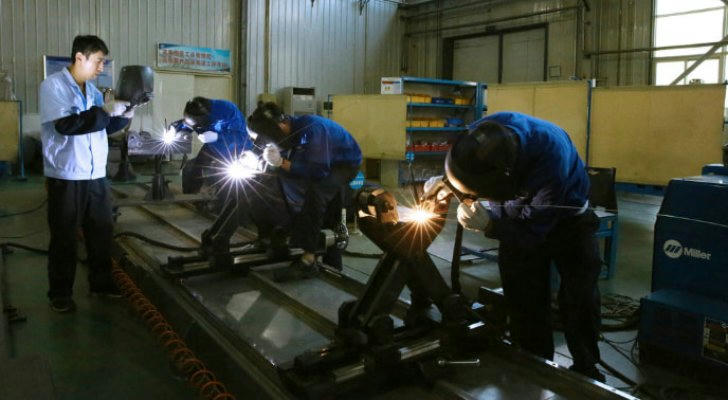American Metal Workers Salary Levels and Application Process
For foreign job seekers seeking high income and stable employment, the U.S. metalworking industry is becoming one of the most attractive blue-collar career choices. This article will systematically analyze the core information about this profession and provide actionable application pathways.

1. Metal Workers Career Introduction
1.1 Career Definition and Job Breakdown
U.S. metal workers include the following key positions:
Welders: Operate arc welding, TIG/MIG welding equipment and must master AWS (American Welding Society) certification standards.
Machinists: Use CNC (Computer Numerical Control) machines to process precision metal parts, requiring the ability to read engineering drawings and programming skills.
Sheet Metal Workers: Specialize in cutting, forming, and installing metal sheets, commonly found in the aerospace and construction industries.
Foundry Workers: Responsible for metal smelting, casting, and post-processing.
1.2 Technical Requirements
- Hard Skills: Equipment operation (e.g., Miller welders, Haas CNC systems), material properties (steel, aluminum, titanium alloys), quality control (CMM measuring instruments).
- Soft Skills: Mathematical calculations (fractions/tolerance conversions), teamwork (assembly line coordination), basic English communication (required to pass OSHA safety training).
1.3 Work Environment
- Manufacturing factories (62%), construction sites (23%), ship repair yards (9%).
- Over 80% of positions provide full safety gear (fire-resistant clothing, breathing masks, noise-canceling ear protection).

2. U.S. Metal Workers Employment Market Analysis
2.1 Job Demand Data
- Overall Shortage: U.S. Bureau of Labor Statistics (BLS) 2023 report cites 417,000 vacancies in the metalworking industry.
- Fastest-Growing Positions:
- CNC Machinists (+15.3% annual growth rate)
- Aerospace Welders (+22.1%)
- Renewable Energy Equipment Manufacturers (+28.4%)
2.2 Regional Distribution Hotspots
| State | Job Density (per 1,000 people) | Key Industries |
|---|---|---|
| Texas | 4.7 | Oil pipelines / Wind power |
| Michigan | 6.2 | Automotive manufacturing |
| California | 3.9 | Aerospace / Semiconductors |
| Ohio | 5.1 | Heavy machinery |
2.3 Employer Types and Stability
- Top Companies: General Electric (GE Aviation), Tesla (Gigafactory), Northrop Grumman (Military).
- Small and Medium Enterprises: Regional metal processing plants (typically offer 3-year long-term contracts).
- Union Protection: Members of the International Association of Machinists (IAM) receive lifetime employment support.

3. Salary Structure and Promotion Opportunities
3.1 Starting Salary and Experience-Based Salary Comparison
| Position | Hourly Wage (USD) | Annual Income (based on 2080 hours) |
|---|---|---|
| Entry-level Welder | 22-28 | 45,760 - 58,240 |
| Level 3 CNC Machinist | 35-42 | 72,800 - 87,360 |
| Senior Sheet Metal Engineer | 48-55 | 99,840 - 114,400 |
3.2 Benefits Package Composition
- Statutory Benefits: Health insurance (employer covers 75% of premiums), 401(k) pension plan (average 4% match), paid vacation (starting at 15 days/year).
- Special Benefits:
- Skill allowance (AWS certification + $5/hour).
- Child education fund (e.g., Ford provides $2,000 per year).
- Overtime pay (weekend work paid at 1.5 to 2 times the regular rate).
3.3 Career Advancement Pathways
- Technical Track: Operator → Quality Control Inspector → Production Supervisor (annual salary up to $120,000).
- Management Track: Team Leader → Shop Manager → Plant Operations Director.
- Entrepreneurship Opportunities: After obtaining ASME certification, start a specialized welding service company.
4. Free Career Training Resources
4.1 Government-Funded Programs
Workforce Innovation and Opportunity Act (WIOA)
- Eligibility: Foreign citizens with legal residency (work visa/green card).
- Coverage: 120 hours of welding/CNC courses + exam certification fees.
- Application: Submit materials via state workforce development agency websites.
Manufacturing Extension Partnership (MEP)
- Offers 6-12 weeks of paid training (hourly wage $16-$18).
- Partner companies: John Deere, Caterpillar, and other Fortune 500 manufacturers.
4.2 Company-Specific Training
Tesla Technical Academy
- Courses: 8-week electric vehicle battery rack welding technology.
- Benefits: Direct hire after graduation, guaranteed first-year income of $62,000.
Boeing Aerospace Skills Center
- Exclusive training: Titanium alloy welding / Non-Destructive Testing (NDT).
- Requirements: Background check (ITAR compliance).
4.3 Community College Programs
- Oakland Community College, Michigan
- Free courses: 240 hours of CNC programming + Mastercam certification.
- Language support: ESL welding terminology tutoring.
Conclusion
The U.S. metalworking industry offers foreign skilled workers clear career progression and legal protection. Through systematic training (minimum 8 weeks) and certification, even individuals with no experience can reach an annual salary of $70,000 within 18 months. Contact the U.S. embassy's commercial section in your country for the latest career immigration quota information.
